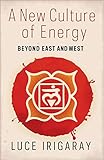A New Culture of Energy : Beyond East and West / Luce Irigaray.
Material type: TextPublisher: New York, NY : Columbia University Press, [2021]Copyright date: 2021Description: 1 online resourceContent type:
TextPublisher: New York, NY : Columbia University Press, [2021]Copyright date: 2021Description: 1 online resourceContent type: - 9780231177122
- 9780231551540
- 615.8/24 23
- online - DeGruyter
| Item type | Current library | Call number | URL | Status | Notes | Barcode | |
|---|---|---|---|---|---|---|---|
 eBook
eBook
|
Biblioteca "Angelicum" Pont. Univ. S.Tommaso d'Aquino Nuvola online | online - DeGruyter (Browse shelf(Opens below)) | Online access | Not for loan (Accesso limitato) | Accesso per gli utenti autorizzati / Access for authorized users | (dgr)9780231551540 |
Frontmatter -- Contents -- PART I: A NEW CULTURE OF ENERGY -- Introduction -- The Liberation of Energy Through Psychoanalysis -- Yoga as a Road to Recovery -- Gaining Autonomy -- Humanizing Our Breath -- Our Body as Mediator -- The Emphasis on Performance Is Rarely Conducive to Exchange -- More Than Not Harming: Loving -- Compassion: The Basis of a Universal Sharing -- Incarnating Ourselves with the Help of Animals and Angels -- Arriving at Speech by Way of Silence -- The Spiritual Path Opened by Sensory Perceptions -- Unity and Duality -- Gods, God, or Another Relationship to the Divine -- A New Culture of Energy -- Myths and History -- PART II: THE MYSTERY OF MARY -- Introduction -- Prologue -- Divine from Birth -- The Event of the Annunciation -- The Virginity of Mary -- The Silence of Mary -- Visible and Invisible -- Touched by Grace -- A Figure of Wisdom -- A Bridge in Time and Space
restricted access online access with authorization star
http://purl.org/coar/access_right/c_16ec
In A New Culture of Energy, Luce Irigaray reflects on three critical concerns of our time: the cultivation of energy in its many forms, the integration of Asian and Western traditions, and the reenvisioning of religious figures for the contemporary world. A philosopher as well as a psychoanalyst, Irigaray draws deeply on her personal experience in addressing these questions. In her view, although psychoanalysis can succeed in releasing mental energy, it fails to support physical and spiritual well-being. In pursuit of an alternative, she took up the bodily practices of yoga and pranayama breathing, which she considers in light of her analysis of sexuate belonging and difference. Reflecting on these practices, Irigaray contrasts yoga’s approach to the natural world with how the Western tradition privileges mastery over nature. These varied sources provoke her to question how a tradition imagines transcendence and the divine. In the book’s final section, she reinterprets the figure of Mary through breath, self-affection, and touch, recalibrating her physicality within a natural world. A reflection on the liberation of human energy, this book urges us to cultivate an evolutionary culture in harmony with all living beings.
Mode of access: Internet via World Wide Web.
In English.
Description based on online resource; title from PDF title page (publisher's Web site, viewed 20. Nov 2024)


